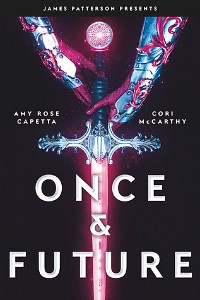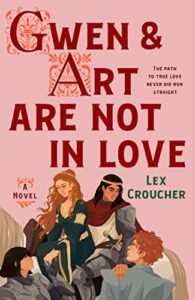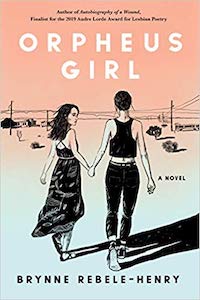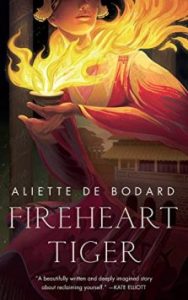Buy this from Bookshop.org to support local bookstores and the Lesbrary!
Once & Future, by married couple A.R. Capetta and Cory McCarthy, takes Arthurian mythos into the stars. It follows the latest, and hopefully last, reincarnation of King Arthur, now a teenage girl named Ari, and the wizard Merlin, who, due to his backwards aging, is now a teenager. Merlin’s job is, and has always been, to keep the Arthurs safe. With her own band of knights (a tight-knit and extremely diverse group of lifelong friends, including a bisexual Guinevere who is queen of her own Renaissance Faire-themed planet!), Ari must step up to defend the galaxy from its next great danger. The great danger that has called Arthur back this time? Space capitalism. (Seriously, the main villain and his company are pretty clear stand-ins for Amazon.)
I’m genuinely so obsessed with this. Listen, I was a Merlin gay in high school, and I still consider it one of my favorite shows, even though there are parts of it I really hate. It’s complicated. This book is not Merlin, it’s not trying to be Merlin, but it does scratch that Merlin itch I get sometimes, and it does it without any of the things that make me angry when I watch that show I still love. Literally every problem I have—absent in this book.
Now to talk about the book itself, I had an actual blast reading it. I laughed so much, felt genuinely sad, and I think I might have cheered out loud at least once. I’m pretty good at judging how I’ll feel about a book before I start it, so I end up enjoying most of the books I read, but this one caught me off guard by how much more I loved it than I was prepared to. Throughout the day, I kept thinking “I can’t wait for my lunch break so I can keep reading,” “I can’t wait to get home so I can keep reading,” “I can’t wait until I finish my dinner so I can keep reading.” I cannot emphasize enough how much I always looked forward to continuing this book when I wasn’t reading it.
I think the main thing I love is the characters. Arthurian retellings can be tricky because there are so many different interpretations of the characters, and someone always ends up getting villainized, and sometimes it’s for reasons that are really stupid. This book does not do that. There is so much sympathy for all of these kids and the archetypes they’ve been slotted into. I loved Ari’s and Gwen’s determination to remain themselves, and I loved how much of Merlin’s arc centered around the idea that he can protect Arthur/Ari while also having a life for himself (and maybe also kiss that cute boy who likes him).
If I had one “note” (I can’t even call it a criticism because for me it wasn’t an issue, but I could see other people feeling different), I will say the relationship development sometimes moved a little quickly, but again, I didn’t mind at all because the relationships, platonic and romantic, were so great.
This is the Arthurian retelling of my dreams. It’s funny, it’s sympathetic, and it’s gay as hell. It is exactly the book I wish existed when I was in high school, but lucky for me now, A.R. Capetta and Cory McCarthy wrote two of them!





